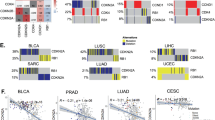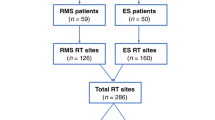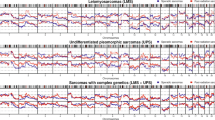Abstract
The tumour suppressor genes, TP53 and RB1, and four genes involved in their regulation, INK4a, ARF, MDM2 and MDMX, were analysed in a series of 36 post-radiotherapy radiation-induced sarcomas. One-third of the tumours developed in patients carrying a germline mutation of RB1 that predisposed them to retinoblastoma and radiation-induced sarcomas. The genetic inactivation of RB1 and/or TP53 genes was frequently observed in these sarcomas. These inactivations were owing to an interplay between point mutations and losses of large chromosome segments. Radiation-induced somatic mutations were observed in TP53, but not in RB1 or in the four other genes, indicating an early role of TP53 in the radio-sarcomagenesis. RB1 and TP53 genes were biallelically coinactivated in all sarcomas developing in the context of the predisposition, indicating that both genes played a major role in the formation of these sarcomas. In the absence of predisposition, TP53 was biallelically inactivated in one-third of the sarcomas, whereas at least one allele of RB1 was wild type. In both genetic contexts, the TP53 pathway was inactivated by genetic lesions and not by the activation of the ARF/MDM2/MDMX pathway, as recently shown in retinoblastomas. Together, these findings highlight the intricate tissue- and aetiology-specific relationships between TP53 and RB1 pathways in tumorigenesis.
This is a preview of subscription content, access via your institution
Access options
Subscribe to this journal
Receive 50 print issues and online access
$259.00 per year
only $5.18 per issue
Buy this article
- Purchase on Springer Link
- Instant access to full article PDF
Prices may be subject to local taxes which are calculated during checkout

Similar content being viewed by others
Accession codes
References
Aerts I, Pacquement H, Doz F, Mosseri V, Desjardins L, Sastre X et al. (2004). Outcome of second malignancies after retinoblastoma: a retrospective analysis of 25 patients treated at the Institut Curie. Eur J Cancer 40: 1522–1529.
Chatterjee SJ, George B, Goebell PJ, Alavi-Tafreshi M, Shi SR, Fung YK et al. (2004). Hyperphosphorylation of pRb: a mechanism for RB tumour suppressor pathway inactivation in bladder cancer. J Pathol 203: 762–770.
Danovi D, Meulmeester E, Pasini D, Migliorini D, Capra M, Frenk R et al. (2004). Amplification of Mdmx (or Mdm4) directly contributes to tumor formation by inhibiting p53 tumor suppressor activity. Mol Cell Biol 24: 5835–5843.
Gonin-Laurent N, Gibaud A, Huygue M, Lefevre SH, Le Bras M, Chauveinc L et al. (2006). Specific TP53 mutation pattern in radiation-induced sarcomas. Carcinogenesis 27: 1266–1272.
Goodrich DW . (2006). The retinoblastoma tumor-suppressor gene, the exception that proves the rule. Oncogene 25: 5233–5243.
Houdayer C, Gauthier-Villars M, Lauge A, Pages-Berhouet S, Dehainault C, Caux-Moncoutier V et al. (2004). Comprehensive screening for constitutional RB1 mutations by DHPLC and QMPSF. Hum Mutat 23: 193–202.
Kato MV, Shimizu T, Ishizaki K, Kaneko A, Yandell DW, Toguchida J et al. (1996). Loss of heterozygosity on chromosome 17 and mutation of the p53 gene in retinoblastoma. Cancer Lett 106: 75–82.
Kawaguchi K, Oda Y, Saito T, Yamamoto H, Takahira T, Kobayashi C et al. (2006). DNA hypermethylation status of multiple genes in soft tissue sarcomas. Mod Pathol 19: 106–114.
Kawaguchi K, Oda Y, Saito T, Yamamoto H, Tamiya S, Takahira T et al. (2003). Mechanisms of inactivation of the p16INK4a gene in leiomyosarcoma of soft tissue: decreased p16 expression correlates with promoter methylation and poor prognosis. J Pathol 201: 487–495.
Kawaguchi K, Oda Y, Sakamoto A, Saito T, Tamiya S, Iwamoto Y et al. (2002). Molecular analysis of p53, MDM2, and H-ras genes in osteosarcoma and malignant fibrous histiocytoma of bone in patients older than 40 years. Mod Pathol 15: 878–888.
Kleinerman RA, Tucker MA, Tarone RE, Abramson DH, Seddon JM, Stovall M et al. (2005). Risk of new cancers after radiotherapy in long-term survivors of retinoblastoma: an extended follow-up. J Clin Oncol 23: 2272–2279.
Knudson AG . (2001). Two genetic hits (more or less) to cancer. Nat Rev Cancer 1: 157–162.
Laurie NA, Donovan SL, Shih CS, Zhang J, Mills N, Fuller C et al. (2006). Inactivation of the p53 pathway in retinoblastoma. Nature 444: 61–66.
Lavin MF, Gueven N . (2006). The complexity of p53 stabilization and activation. Cell Death Differ 13: 941–950.
Lefèvre SH, Vogt N, Dutrillaux AM, Chauveinc L, Stoppa-Lyonnet D, Doz F et al. (2001). Genome instability in secondary solid tumors developing after radiotherapy of bilateral retinoblastoma. Oncogene 20: 8092–8099.
Marine JC, Jochemsen AG . (2004). Mdmx and Mdm2: brothers in arms? Cell Cycle 3: 900–904.
Menu-Branthomme A, Rubino C, Shamsaldin A, Hawkins MM, Grimaud E, Dondon MG et al. (2004). Radiation dose, chemotherapy and risk of soft tissue sarcoma after solid tumours during childhood. Int J Cancer 110: 87–93.
Miller CW, Aslo A, Won A, Tan M, Lampkin B, Koeffler HP . (1996). Alterations of the p53, Rb and MDM2 genes in osteosarcoma. J Cancer Res Clin Oncol 122: 559–565.
Moysich KB, Menezes RJ, Michalek AM . (2002). Chernobyl-related ionising radiation exposure and cancer risk: an epidemiological review. Lancet Oncol 3: 269–279.
Patino-Garcia A, Sierrasesumaga L . (1997). Analysis of the p16INK4 and TP53 tumor suppressor genes in bone sarcoma pediatric patients. Cancer Genet Cytogenet 98: 50–55.
Perucca-Lostanlen D, Rostagno P, Grosgeorge J, Marcie S, Gaudray P, Turc-Carel C . (2004). Distinct MDM2 and P14ARF expression and centrosome amplification in well-differentiated liposarcomas. Genes Chromosomes Cancer 39: 99–109.
Ramos YF, Stad R, Attema J, Peltenburg LT, van der Eb AJ, Jochemsen AG . (2001). Aberrant expression of HDMX proteins in tumor cells correlates with wild-type p53. Cancer Res 61: 1839–1842.
Sartor M, Steingrimsdottir H, Elamin F, Gaken J, Warnakulasuriya S, Partridge M et al. (1999). Role of p16/MTS1, cyclin D1 and RB in primary oral cancer and oral cancer cell lines. Br J Cancer 80: 79–86.
Sharpless NE . (2005). INK4a/ARF: a multifunctional tumor suppressor locus. Mutat Res 576: 22–38.
Shaw RJ, Liloglou T, Rogers SN, Brown JS, Vaughan ED, Lowe D et al. (2006). Promoter methylation of P16, RARbeta, E-cadherin, cyclin A1 and cytoglobin in oral cancer: quantitative evaluation using pyrosequencing. Br J Cancer 94: 561–568.
Toledo F, Wahl GM . (2006). Regulating the p53 pathway: in vitro hypotheses, in vivo veritas. Nat Rev Cancer 6: 909–923.
Travis LB . (2002). Therapy-associated solid tumors. Acta Oncol 41: 323–333.
Tsuchiya T, Sekine K, Hinohara S, Namiki T, Nobori T, Kaneko Y . (2000). Analysis of the p16INK4, p14ARF, p15, TP53, and MDM2 genes and their prognostic implications in osteosarcoma and Ewing sarcoma. Cancer Genet Cytogenet 120: 91–98.
Wakeford R . (2004). The cancer epidemiology of radiation. Oncogene 23: 6404–6428.
Acknowledgements
N G-L was a fellow of the Ministère de l'Education Nationale et de la Recherche and of the Association pour la Recherche contre le Cancer (ARC). Supported by: Institut Curie-CEA ‘Programme Incitatif et Coopératif Instabilité génétique et radiorésistance des tumeurs’; Institut Curie ‘Programme Incitatif et Coopératif Rétinoblastome’; Electricité de France (RB2005–10); CEA (LRC38).
Author information
Authors and Affiliations
Corresponding author
Additional information
Supplementary Information accompanies the paper on the Oncogene website (http://www.nature.com/onc).
Rights and permissions
About this article
Cite this article
Gonin-Laurent, N., Hadj-Hamou, N., Vogt, N. et al. RB1 and TP53 pathways in radiation-induced sarcomas. Oncogene 26, 6106–6112 (2007). https://doi.org/10.1038/sj.onc.1210404
Received:
Revised:
Accepted:
Published:
Issue Date:
DOI: https://doi.org/10.1038/sj.onc.1210404
Keywords
This article is cited by
-
Mice with Trp53 and Rb1 deficiency in chondrocytes spontaneously develop chondrosarcoma via overactivation of YAP signaling
Cell Death & Disease (2022)
-
Radiation-induced malignancies after intensity-modulated versus conventional mediastinal radiotherapy in a small animal model
Scientific Reports (2019)
-
Genomic and transcriptomic comparison of post-radiation versus sporadic sarcomas
Modern Pathology (2019)
-
Radiation-induced osteosarcoma of the skull base after radiation therapy in a patient with nasopharyngeal carcinoma: a case report and review of the literature
Journal of Medical Case Reports (2016)
-
Mutational signatures of ionizing radiation in second malignancies
Nature Communications (2016)



